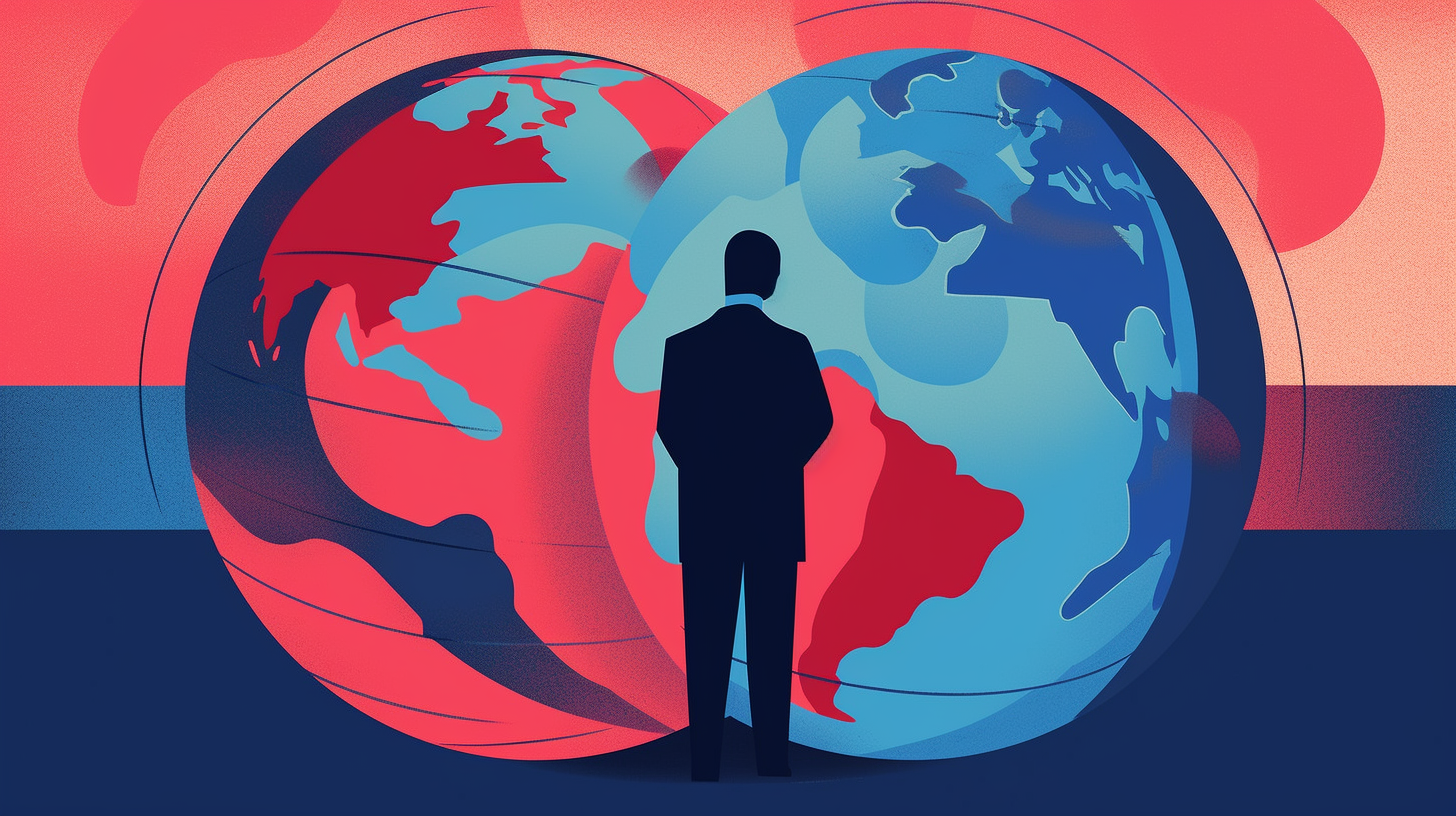A Tale of Two Blocs: The Geopolitical Implications of Divergent AI Policies
The contrasting paths of Authoritarian and Democratic Liberal Blocs in AI policy reveal far-reaching consequences, emphasizing the urgency for a global dialogue to balance technological progress with ethical considerations.

Knee-jerk policy decisions driven by legitimate concerns about the near-term impact of generative AI could create enormous geopolitical power imbalances over the course of just a few years. Democracies must navigate this process and chart a course that both maximally leverages the efficiencies and capabilities of AI (because efficiency and competitiveness are no longer optional) while ensuring that all layers of society benefit from the resulting transformation. If not, hostile forces unencumbered by many of those concerns will be poised to seize the advantage. I asked GPT-4 to explore this concept in the following scenario. This piece was crafted from multiple prompts. The model created the title and excerpt as well.
I created the cover photo for this post with Midjourney.
In this hypothetical scenario, the world is divided into two distinct blocs: the democratic, liberal bloc (DLB) and the authoritarian bloc (AB). The DLB decides to outlaw AI research and implementation, while the AB embraces and invests heavily in AI. This essay will analyze the paths taken by these two blocs over the next two decades, focusing on the shift in the geopolitical balance of power and the eventual outcome for the global order.
The Democratic Liberal Bloc's Path
Driven by concerns over privacy, mass surveillance, and potential job losses, the Democratic Liberal Bloc (DLB), led by major democratic powers, enacts a ban on AI research and implementation. This decision, while aiming to protect individual liberties, inadvertently curtails technological progress and economic competitiveness.
In the wake of this ban, the DLB experiences economic and technological stagnation, as industries struggle to maintain efficiency and competitiveness in the absence of AI advancements. This decline leads to stunted economic growth, a widening technological gap, and diminished global influence.
The repercussions of the AI ban also extend to social and political spheres, impacting the DLB's ability to counter disinformation, address climate change, and improve healthcare outcomes. As the consequences become more apparent, frustration among the populace mounts, with many viewing the government's decision as an obstacle to progress and a detriment to their quality of life.
The Authoritarian Bloc's Path
Seizing the opportunity to gain an edge, the Authoritarian Bloc (AB), led by major authoritarian powers, fully embraces AI and heavily invests in its development. The AB harnesses AI to fortify its governance, boost economic productivity, and amplify military capabilities.
Propelled by these investments, the AB experiences rapid economic growth and technological breakthroughs, eclipsing the DLB. This newfound dominance allows the AB to conquer emerging markets, attract foreign investment, and establish itself as the global leader in AI.
However, this ascendance comes at a cost, as the AB deploys AI to bolster its surveillance capabilities and create an Orwellian society with diminished individual freedoms. Citizens are subject to constant monitoring, and any dissent is promptly quashed through the use of AI-driven technologies.
The Authoritarian Bloc's Ruthless Rise
As the technological gap grows, the Authoritarian Bloc (AB) will seek to exploit its AI-driven advantages to aggressively undermine the Democratic Liberal Bloc (DLB). The AB's approach to harnessing AI extends across a wide range of applications, from manipulating public opinion through disinformation campaigns to asserting dominance in the global economy. This multifaceted strategy highlights the potential risks and consequences of the DLB's decision to ban AI research and implementation, as it struggles to counter the rising influence and power of the AB.
One of the AB's key tactics is the use of advanced AI algorithms to create and disseminate disinformation, targeting the DLB's social and political fault lines. These efforts are aimed at destabilizing the DLB's societies, polarizing public opinion, and weakening trust in democratic institutions. The AI-powered disinformation campaigns are highly adaptive, making them difficult for the DLB to counter without their own AI capabilities.
The AB also employs AI in a variety of industries, allowing it to rapidly outpace the DLB economically. It leverages this advantage by flooding global markets with cheap, high-quality goods produced by AI-driven factories, undercutting DLB's industries and leading to widespread job losses. Additionally, the AB uses AI to manipulate global financial markets, creating economic turmoil in the DLB and undermining its economic stability.
In the realm of cyberwarfare and espionage, the AB's AI-driven capabilities far surpass those of the DLB. It conducts sophisticated cyber attacks on the DLB's critical infrastructure, including power grids, communication networks, and transportation systems. These attacks can cripple entire regions and create chaos. The AB also uses AI-enhanced espionage to infiltrate the DLB's governments, military, and private industries, stealing sensitive information and intellectual property.
Moreover, the AB invests heavily in AI-driven military technologies, such as autonomous drones, advanced targeting systems, and AI-enhanced cyber warfare capabilities. These investments significantly enhance the AB's military power, allowing it to project force around the globe and intimidate the DLB and its allies. The DLB's military, lacking AI advancements, finds it increasingly difficult to match the AB's capabilities.
As the AB's power grows, it becomes more aggressive in its efforts to expand its influence. It uses AI-driven surveillance technologies to monitor and suppress domestic dissent, ensuring loyalty and stability at home. Internationally, the AB employs a combination of economic incentives, military threats, and political pressure to coerce smaller nations into aligning with its interests. This undermines the DLB's influence, as more countries find themselves drawn into the AB's orbit.
Lastly, the AB invests in AI-driven biotechnology research, leading to breakthroughs in areas such as genetically modified organisms, advanced pharmaceuticals, and personalized medicine. This gives the AB a significant advantage in agriculture, healthcare, and even biological warfare. Additionally, the AB uses AI to monitor and manipulate the environment, potentially weaponizing natural disasters or controlling vital resources, further extending its dominance over the DLB.
The AI Policy Crossroads and Its Impact on World Order
The AI-driven trajectory of both the Authoritarian Bloc and the Democratic Liberal Bloc showcases a striking contrast in global dynamics, with profound implications for the future of international relations and the balance of power. The aggressive exploitation of AI by the AB across numerous domains severely undermines the DLB's position on the world stage, as they grapple with the far-reaching consequences of their decision to ban AI research and implementation.
This growing imbalance between the two blocs threatens to reshape the geopolitical landscape, with the AB's increasing dominance potentially destabilizing the global order and heightening the risk of conflict. As the DLB faces mounting challenges, including economic stagnation, social unrest, and a diminished ability to counter external threats, the need to reevaluate their stance on AI becomes more pressing.
The stark divergence between the two blocs underscores the importance of striking a delicate balance between technological competitiveness and ethical considerations in an increasingly complex and polarized world. To forge a sustainable and secure future, both blocs must engage in a global dialogue that addresses the challenges and opportunities presented by AI, balancing the pursuit of innovation with the protection of fundamental values and principles.
Ultimately, the divergent paths taken by the DLB and AB serve as a cautionary tale, highlighting the need for a nuanced approach to AI and its potential consequences. In a world marked by rapid technological advancements and shifting power dynamics, the pursuit of a balanced approach to AI is crucial for maintaining stability, security, and global cooperation.
Blogs of War generated this text in part with GPT-4, OpenAI’s large-scale language-generation model. Upon generating draft language, the author reviewed, edited, and revised the language to their own liking and takes ultimate responsibility for the content of this publication.
